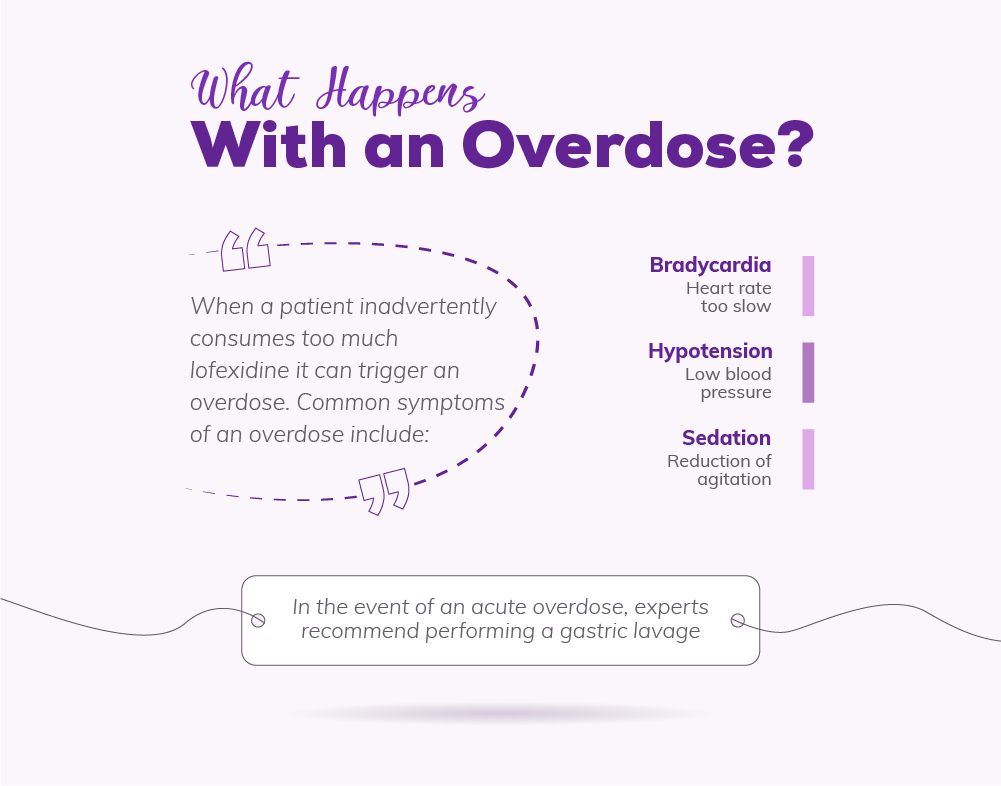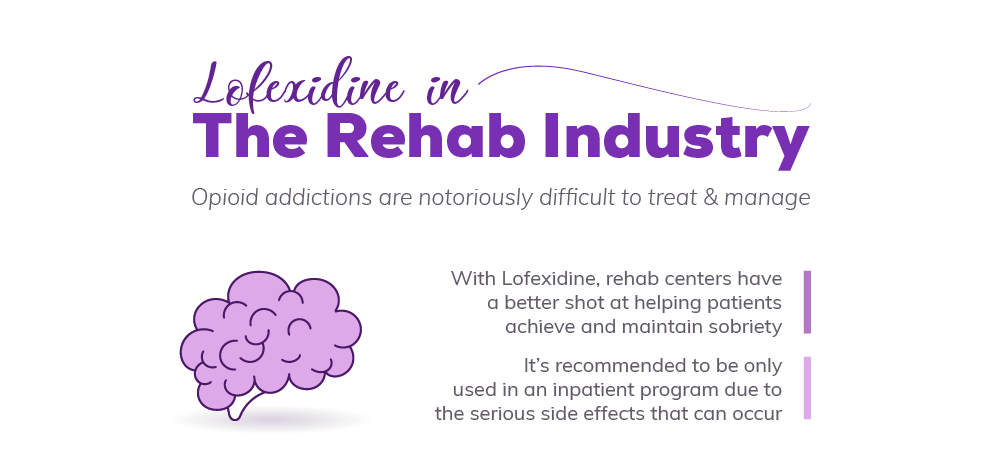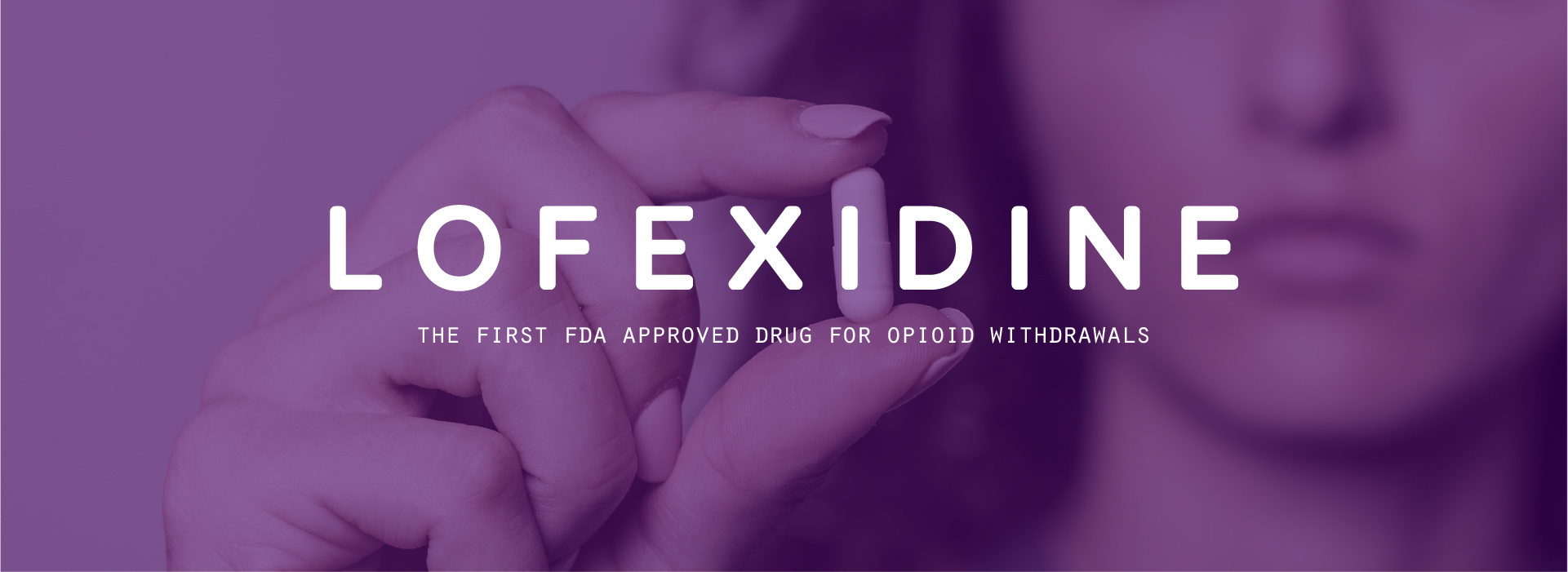There’s some fairly exciting news happening in the addiction recovery industry. The U.S. Food and Drug Administration (FDA) has finally approved a prescription medication for managing opioid withdrawal symptoms. This medication is known as lofexidine. Lofexidine is sold under the brand name Lucemyra. This non-opioid prescription medication is used specifically to treat opioid withdrawals. It can ease the severity of withdrawal symptoms although it may not completely prevent them. Currently, this treatment is only approved for up to 14 days of treatment. The reason that Lucemyra is so special is because it’s a not an opioid. It has a low potential for abuse. It doesn’t act on opioid receptors in the central nervous system (CNS). Before the FDA approved lofexidine, methadone and Suboxone were the two most popular opioid addiction treatment medications. Both of these prescription drugs are opioids. They come with a potential for abuse, and it’s possible for patients to develop a secondary addiction. With this new prescription medication, none of the previous concerns are valid. This prescription drug can help many opioid addicts finally get over an opioid addiction. Although lofexidine is not a “cure”, it can be incorporated into any opioid addiction treatment plan. Unlike with Suboxone and methadone, this prescription drug is not involved in the long-term maintenance of opioid abstinence. Those who take these drugs will only do so for up to 14 days. Here’s a much more in-depth look at lofexidine and what it does.
“We accept many health insurance plans. Get your life back in order, take a look at our outpatient program.”
Opioid Addiction and Treatment Statistics
An opioid epidemic has spread across America. Prescription opioids are some of the most commonly abused drugs in all states. Addicts, who were once hooked on prescription opioids, are more likely to switch to illicit opioids when their prescription runs out. To illustrate the severity of the opioid epidemic in America, take a look at some of these statistics:
- 80% of heroin addicts reported misusing prescription opioids first before switching to illicit drugs
- 19,413 of the 42,249 fatal overdose in 2016 were caused by synthetic opioids, like fentanyl
- 80% of overdose deaths involved synthetic opioids, even if they were mixed with other drugs and substances
- Over 500,000 Americans are projected to succumb to opioid-related overdoses in the next decade
Opioid addiction is a huge problem in America. It affects a lot of people. Finding more medications and solutions for treating this epidemic will benefit the rehab industry and the medical industry tremendously. 
What Is Lofexidine? What Does It Do?
Lofexidine is taken orally. It’s a selective alpha 2-adrenergic receptor agonist that inhibits the release of norepinephrine. This agonist binds to receptors on adrenergic neurons. It does not attach to opioid receptors in the central nervous system (CNS) like Suboxone and methadone. By reducing the release of norepinephrine, lofexidine is able to decrease sympathetic tone and responses. This basically lessens the intensity of opioid withdrawal symptoms. Lofexidine is capable of easing the following opioid withdrawal symptoms:
- Anxiety
- An overall feeling of sickness
- Diarrhea
- Heart palpitations
- Insomnia and other sleeping problems
- Muscle cramps and twitching
- Muscular tension, aches and pains
- Nausea and vomiting
- Runny eyes and noses
- Stomach cramps
It’s also capable of managing some other symptoms often experienced when withdrawing from opioids and opiates. These withdrawal symptoms often keep patients from successfully getting sober.
“This is an extraordinarily difficult cluster of symptoms to treat, and I felt that the differences shown were clinically meaningful” ~ Felipe A. Jain, MD, assistant clinical professor of psychiatry, University of California, San Francisco.
By easing these withdrawal symptoms, opioid abusers have an easier time getting sober. They are less likely to relapse or to drop out of the substance abuse treatment program. One of the main reasons why opioid addicts have a hard time getting clean is because the withdrawal symptoms are often unbearable. The symptoms are comparable to a horrible, terrible and long-lasting flu. It’s highly uncomfortable. It’s important to note that Lucemyra can only lessen the intensity of these symptoms. They cannot prevent them entirely. Often times, drug abusers will still experience some of these symptoms. However, these symptoms will feel a lot more manageable.
What Is Norepinephrine and What Does It Do?
Studies have found that norepinephrine plays a crucial role in opioid withdrawal symptoms. Elevated levels of norepinephrine appear to be the main culprit for opioid withdrawals. Opioid abuse appears to have an effect on neurochemical levels. It causes them to go haywire. The brain begins to have difficulties differentiating what is considered ‘normal levels’ and what is an abnormality. Norepinephrine is a natural neurochemical that is released in the body. It’s general function is basically to mobilize the brain and body, so that they’re ready for action. For example, norepinephrine levels are relatively low when one is sleeping. It will, however, reach peak levels when a person is in stress or in danger. When norepinephrine levels elevate in the brain after opioid abuse, it causes many of the biological pathways to go haywire. They start to become overstimulated. This is the reason behind why many people experience uncomfortable withdrawal symptoms. An increase in norepinephrine can result in:
- An increased heart rate
- Restlessness
- An increase in blood pressure
- Elevated glucose levels
- An increase in blood flow to skeletal muscles
- Inhibition of gastrointestinal motility
In the brain, norepinephrine can also increase arousal and alertness. This can cause the patient to experience insomnia or to feel paranoid and anxious. Opioid withdrawal medications should be able to find a way to keep norepinephrine levels low. This is precisely what lofexidine is able to accomplish.
What Does this Prescription Drug Look Like?
Lucemyra is available on the market as a round, peach-colored pill. It is a film-coated tablet. The letters “LFX” are imprinted on one side, and the number “18” is imprinted on the other side. The number ‘18’ stands for the dose. Each tablet contains 0.18 mg of lofexidine. This is equivalent to about 0.2 mg of lofexidine hydrochloride.
Dosage Information
Most patients start off taking three 0.18mg tablets of Lucemyra four times per day during peak withdrawals. Patients should take the medication every 5 to 6 hours. These prescription drugs can be taken with or without food. The daily dosage of lofexidine should not exceed 2.88mg or 16 tablets. Also, no single dose should exceed a dose of 0.72mg or 4 tablets. Patients can continue this treatment for up to 14 days, as mentioned above. The dosing can be guided by the intensity and severity of the opioid withdrawal symptoms. To discontinue this medication, patients will gradually taper their dose over a 2 to 4 day schedule. This helps ease lofexidine withdrawal symptoms. In general, most experts recommend reducing the dose by 1 tablet every 1 to 2 days. If opioid withdrawal symptoms wane more quickly for some patients, they can start to gradually reduce their dosage even sooner. Upon ingestion, the body quickly absorbs Lucemyra. This prescription drug achieves peak plasma concentrations in about 3 to 5 hours.
For Those with Hepatic Impairment
A lower dose is recommended for those with hepatic impairment. The severity of the impairment is calculated with a Child-Pugh score. Here’s the recommended dose for the following Child-Pugh scores:
- 5 to 6, which indicates a mild hepatic impairment. These patients should take 3 tablets four times a day for a total daily dose of 2.16 mg.
- 7 to 9, which indicates a moderate hepatic impairment. These patients should take 2 tablets four times a day for a maximum daily dose of 1.44 mg.
- Over 9, which indicates a severe hepatic impairment. These patients should take 1 tablet four times a day for a total daily dose of 0.72 mg.
Those with a hepatic impairment are more at risk of experiencing QT prolongation. Addiction experts may want to monitor the patient’s hepatic condition throughout the treatment.
For Those with Renal Impairment
A lower dose is also recommended for those with renal impairment. The severity of the renal impairment is measured by the estimated GFR, mL/min/1.73 m^2. Patients with renal impairment can take Lucemyra without any regard to the timing of their dialysis. Those with a mild to moderate impairment will have an estimated GFR, mL/min/1.73 m^2 between 30 and 89.8. These individuals should take 2 lofexidine tablets four times daily for a total dose of 1.44 mg. Those with a severe impairment or those at the end stage of a renal disease will have an estimated GFR, mL/min/1.73 m^2 under 30. These individuals should take only 1 Lucemyra tablet four times daily for a maximum total daily dose of 0.72 mg. A renal impairment can interfere with lofexidine’s mechanism of action. Too high of a dose could result in prolongation of the QTc interval. Renal impairment will actually slow down the elimination and breakdown of Lucemyra.
“Get your loved one the help they need. We provide outpatient addiction treatment in Denver and Summit County, see more here.”

What Happens with an Overdose
It’s possible to take too large of a dose of lofexidine. An overdose with lofexidine may manifest as the following symptoms:
- Bradycardia
- Hypotension
- Sedation
In the event of an acute overdose, some experts may recommend performing a gastric lavage. The rehab center will need to initiate general symptomatic and supportive measures. It’s important to note that it’s not difficult to overdose on this drug. This is why many alcohol and drug treatment centers recommend an inpatient detox program. Since patients will be under constant supervision, their condition will be monitored. If anything odd arises, the medical professionals will catch on almost immediately. They’ll be able to ensure that the patient’s well being is not negatively impacted.
Successful Studies with Excellent Results
The FDA would only approve a new prescription drug for treating opioid withdrawal symptoms if it can yield impressive results. Lofexidine trials have yielded many successful results. Let’s take a look at two studies that are highly referred to: Study 3002 and Study 3003-1. In both studies, the patients struggled with opioid use disorders and had a physical dependence to either heroin or short-acting opioids. In Study 3002, patients were given either a placebo or 3.2mg of lofexidine for 5 days. In Study 3003-1, patients were either given a placebo or either 3.2 mg or 2.4 mg of lofexidine every day for 7 days. Patients were treated at community treatment centers or private research centers. All patients received bed-based care setting treatment. They also had to be actively trying to withdraw from opioids and opiates. In addition, patients could not be also struggling with a mental health disorder or any other medical condition. A co-occurring disorder is when a patient has both a substance use disorder and a mental health disorder. Patients that used any type of psychiatric drugs were also excluded from the study. Study 3002 had 264 patients. Study 3003-1 had 602 patients. Each patient was evaluated using the Short Opiate Withdrawal Scale of Gossop (SOWS-Gossop). Patients are asked to rate 10 symptoms either none, mild, moderate or severe. The maximum possible score for this assessment is 30. With a score of 30, the rating for every symptom would be severe. In Study 3002, patients experienced a significant 2-point-lower score on SOWS-Gossop. This is in comparison to those who took the placebo. There was also a difference among patients in Study 3003-1. The difference was less pronounced. There was only a 0.3 difference. 
Side Effects, Warnings and Precautions of Taking Lucemyra
Although many wonderful test results have come from Lucemyra, this drug also comes with a wide array of side effects and warnings. Some of the more common side effects of Lucemyra include:
- Dizziness and sedation
- Dry mouth
- Fainting, or syncope
- Low blood pressure or hypotension
- Sleepiness, or somnolence
- Slowed heart rate, otherwise known as bradycardia
- QT prolongation
It’s important to note that this drug can affect the heart’s electrical activity. As a result, it can cause arrhythmia, or abnormal heart rhythms. Another adverse effect that can happen from taking lofexidine is a sudden increase in blood pressure. This only happens when patients stop taking the drug.
An Important Consideration: Lofexidine Has a High Dropout Rate
Success rates were relatively high for those who completed their lofexidine treatment. With that said, a number of patients did drop out from the study. They were unable to complete the treatment. In study 3002, only about 49% of lofexidine patients were able to complete a 5-day treatment regimen. These numbers are still relatively better than the 33% of patients who completed the placebo treatment. Patients who received the 3.2mg dose were most likely to drop out. Patients who dropped out did so for the following reasons:
- Approximately 5% of patients dropped out because of bradycardia
- Around 3% discontinued Lucemyra use due to hypotension
- About 3% stopped taking lofexidine due to orthostatic hypotension
- Another 3% of patients stopped the treatment due to insomnia
Patients who took a lesser dose of 2.4 mg were more likely to complete the treatment. With that said, those who took the prescription pills were more likely to complete the study when compared to those who took a placebo.
“We treat both addiction and co-occurring disorders and accept many health insurance plans. Take a look at our outpatient rehab program.”
Is Lofexidine Suitable for Pregnant Women?
22.8% of women who were enrolled in a Medicaid program were addicted to prescription opioids. A huge number of opioid users are pregnant women. In fact, there was a fivefold increase in maternal opioid use between 2000 to 2009. Unfortunately, the safety of lofexidine for pregnant women has yet to be established. There’s only research on the effects of the drug among animal test subjects. Oral administration of Lucemyra to pregnant rats and rabbits caused some negative consequences. They include:
- A reduction in fetal weights
- Increases in fetal resorption
- Litter loss and stillbirths
The offspring of these test subjects also exhibited delayed sexual maturation. They were also more easily started through auditory stimuli. With that said, lofexidine use among pregnant women is not recommended at this time. Further research is needed in this area. This prescription drug for opioid addiction may cause major birth defects.
Other Areas that Need Further Research
There’s still a lot of research that needs to go into lofexidine. The FDA has proposed 15 additional post-marketing studies. They include:
- Animal safety studies that look at the safeness of long-term use of this drug
- Animal safety studies and clinical studies on the effects of Lucemyra on the liver and on blood pressure
- Clinical studies among pediatric patients, like newborns with neonatal opioid withdrawal symptoms and children of different age groups with opioid withdrawal symptoms
With that said, this drug is deemed safe for the average adult addict. In fact, it’s proven itself to be quite effective. 
What Does This Mean for Addicts?
So, what does the approval of lofexidine by the FDA mean for addicts? For one, it means that there’s another option for treating opioid withdrawal symptoms. Everyone’s body reacts differently to various prescription drugs. With more options available, opioid addicts are more likely to get find a treatment plan that will work for them.
“Today’s approval represents the first FDA-approved non-opioid treatment for the management of opioid withdrawal symptoms and provides a new option that allows providers to work with patients to select the treatment best suited to an individual’s needs.” ~ Sharon Hertz, M.D., director of the Division of Anesthesia, Analgesia and Addiction Products in the FDA’s Center for Drug Evaluation and Research
Opioid addicts have a better shot at recovery. Lofexidine can be paired with many other addiction treatments, like therapeutic interventions, to help opioid abusers get sober and clean. Common therapeutic interventions that are also used include family, group and individual counseling. Cognitive Behavioral Therapy (CBT) and Dialectical Behavioral Therapy (DBT) are also great options. Behavioral therapy can modify one’s behavior towards substance abuse. 
What Does This Mean for the Rehab Industry?
This is also good news for the rehab industry. Opioid addictions are notoriously difficult to treat and manage. With the approval of a new prescription drug, the rehab industry is able to better cater to patients. Rehab centers will have a better shot at helping patients achieve and maintain sobriety. With that said, lofexidine is a fairly new drug. The rehab industry will still need to figure out how to best incorporate this prescription medication into its treatment programs. Since Lucemyra is associated with some fairly heavy side effects, it’s currently recommended for inpatient drug detoxification programs. If used in outpatient programs, patients must be fully informed of the type of side effects that may come with lofexidine use. They should also be made aware of when they should seek medical help. If you’re interested in lofexidine, you should consider asking rehab centers whether they intend on taking a look at this new drug and what it has to offer. Rehab centers that continuously pursue a better understanding of the latest research will offer a higher quality of care.
New Hope for Opioid Addicts and Abusers
There’s new hope on the horizon for those who are addicted to opioids. Lofexidine may be the answer to all of their troubles. Although this prescription medication isn’t a “cure”, it can treat many withdrawal symptoms that often cause drug abusers to relapse. It can make getting sober a much more pleasant experience. Addicts will be able to avoid intense and, often, overbearing withdrawal symptoms. Here, at Denver Women’s Recovery, we offer a wide range of treatment options for our patients. We currently offer several different detox options for opioids and opiates, and are looking to incorporate new medications into our treatment programs. We’re always interested in new evidence-based treatment approaches that may help our patients. If you’ve been struggling with an opioid addiction, don’t hesitate to reach out to us. Our addiction specialists can walk you through the various treatment plans we offer. We can also assess your addiction and help you determine which options may be most effective for your situation. Leave the logistics and the complicated parts of addiction recovery to us! Focus on your recovery. With a little perseverance, motivation and discipline, sobriety is just an arm’s reach away.








